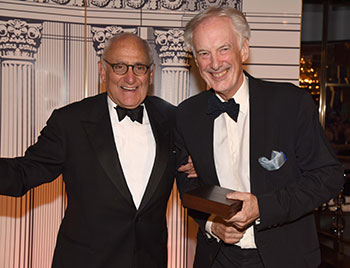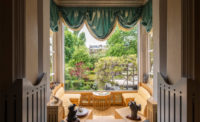American-born cultural theorist, architect, and landscape designer Charles Jencks died in his home in London on October 13. He was 80 years old. Robert A.M. Stern, Paul Goldberger, and George Baird have offered these tributes to RECORD, recalling the varied contributions Jencks made over his lifetime—including co-founding the network of cancer-care facilities called Maggie’s Centres, after his wife, Maggie Keswick, died in 1995.
Robert A.M. Stern
No one more tirelessly or more provocatively traced and charted the ins and outs and ups and downs of postmodern architectural taste than Charles Jencks. A graduate of Harvard College and the Graduate School of Design, Charles Jencks held a Ph.D. in Architectural History from London University. From his earliest books—Meaning in Architecture, co-edited with George Baird, Adhocism, written with Nathan Silver; and Modern Movements in Architecture—to his endlessly revised and epochally influential The Language of Post-Modern Architecture, to his more recent books The Architecture of the Jumping Universe of 1995 and Ecstatic Architecture of 1999, Charles Jencks not only provided us with invaluable chronicles and dramatic comparisons but also provocative opinions. Charles was a great synthesizer, helping architects to see their own work in relationship to the other arts, to politics, to popular culture, and especially to the world of science. While Charles's principal interest was architecture, in recent years he also turned his attention to landscape, assisting his late wife Maggie Keswick on her book The Chinese Garden and collaborating with her on important new landscapes based on complexity theory. Working independently, he completed DNA sculptures for the scientist James Watson at Cold Spring Harbor Laboratories on Long Island and for Matt Ridley, Centre of Life, at Newcastle, England.
I first encountered the full force of Charles Jencks when in 1973 he published a scrubbed-up version of his University College, London thesis as Modern Movements in Architecture. This book was a game-changer for me and others who were fed up with the scholarly masquerade of Sigfried Giedion's Space, Time and Architecture, a book that presented the story of 19- and 20-century architecture as a highly selective linear narrative that left little or no room for idiosyncrasy, not to mention dissent. Jencks's book changed everything, opening the door to the widest possible view of what modern architecture actually had been in the nineteenth and twentieth centuries—the book was a breath of fresh air and a great work of scholarship. Then Jencks published another game-changing book, The Language of Post-Modern Architecture. First appearing in 1977, and very many times revised since then, Jencks's Post-Modern book blew apart the smug self-referential and self-abasing Modernism of the post-World War II era and opened readers to a new world of possibilities. So with one book he looked back to where architecture had been; and with another he pushed the story into the present and future.

As a synthesizer Jencks was a public intellectual; but he was also a talented designer. Jencks's London terrace house, designed with Terry Farrell's collaboration, is as near to Sir John Soane's house as any in our time. Soane's house was conceived as a vessel in which to display artifacts ranging from antiquity to modern times, principally to educate young would-be architects in the craft and culture of their discipline. Ever the engaged historian, building his house in the early 1980s, Charles did not collect artifacts but instead collected young architects such as Michael Graves, Terry Farrell, and Piers Gough who were invited to decorate walls and design furniture so that the house is a perfect expression of the now-historical Post-Modern movement its owner did so much to define. The Thematic House, Charles's house of symbols, is the only house realized in our time that can truly compete with the Soane Museum in presenting the ideas of a great master educator in such a startling, enlightening, and irresistible manner.
– Robert A.M. Stern
Paul Goldberger
Charles Jencks’s prolific oeuvre as an architectural historian of the modern and post-modern eras—the Linnaeus of architecture history, as I liked to call him, given his love of classifications and sub-classifications and categories of all kinds—was sufficient to stand as a life’s work in itself. But then there was his second career as the creator of the extraordinary Maggie’s Centers, when he commissioned great architects of the world to design treatment centers in memory of his wife, a magnificent act of social responsibility joined to architectural patronage. And then there was his third career as a brilliantly inventive landscape architect, where he struggled to unite his philosophical bent to creative design. Charles brought wit and humanity as well as dazzling insight to every phase of his life, and architecture is the richer for it. For more than four decades I have learned from him, argued with him, and been inspired by him.
–Paul Goldberger
George Baird
I first met Charles Jencks upon becoming a doctoral candidate in architecture at the Bartlett School of Architecture in London in 1964, where I soon discovered that he was also a doctoral candidate there. We quickly became friends, and worked extensively together, especially on the project in architectural theory that became the book Meaning in Architecture published in 1969.
Charles and I had many adventures together, including vacationing for a week with our wives as guests of his friend Varian Fry, an American who was a legendary rescuer during World War II of Jewish European intellectuals and artists during the occupation of France. We stayed in a house in Provence that Fry had been given the use of by one of those he rescued, Marc Chagall, and it was a high point of my life.
After Meaning in Architecture was published, Charles and my career paths diverged somewhat, with his becoming the author of the prominent publication The Language of Postmodern Architecture in 1977, and I continuing my work on the influence of Hannah Arendt in contemporary architectural theory (The Space of Appearance, 1995).
It is certainly true that Charles’s high-profile promotion of Postmodernism—a movement about which I have had decidedly mixed feelings—put a strain on our friendship. But we became close friends again in recent years. During a recent visit to London, I spent a happy couple of hours in conversation with him, despite his undergoing a recurrence of multiple forms of cancer.
Looking back on his career, and on our long friendship, what was for me the defining feature of his personality is what I would call his “energetic innocence.” When I first identified this feature, I saw it as an idiosyncratic weakness, but over time, I came to realize that it was instead, a great strength: during the great hurly-burly of architectural polemics over the last half-century and even ad-hominem attacks that Charles faced, he could never be intimidated.
—George Baird


